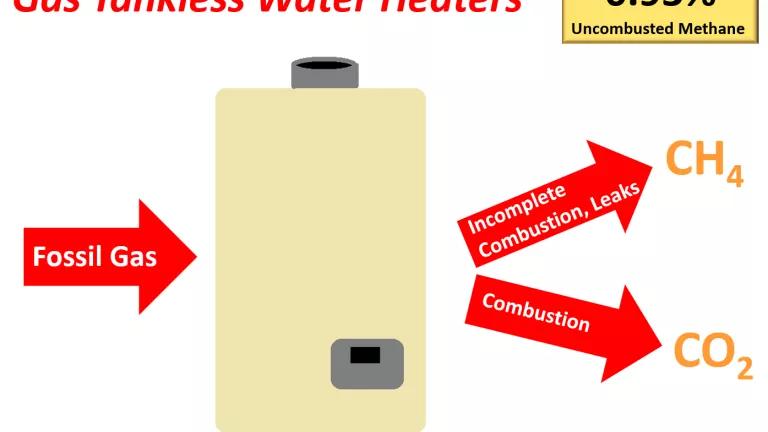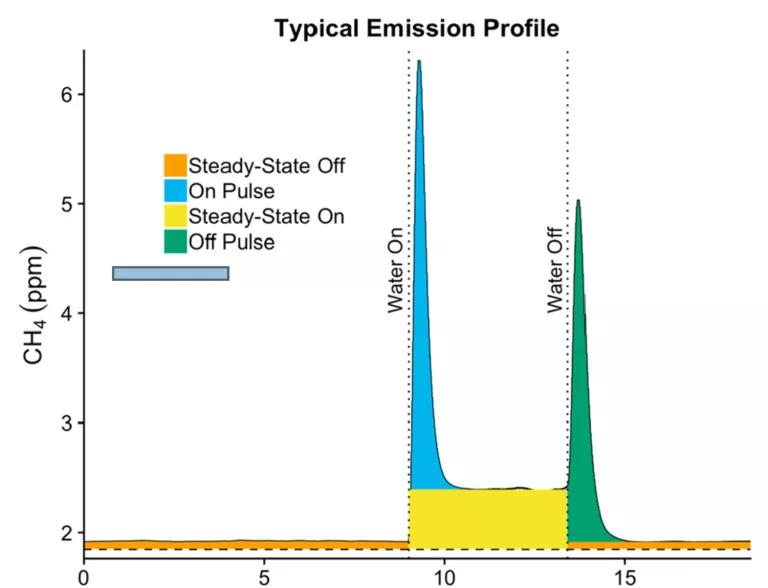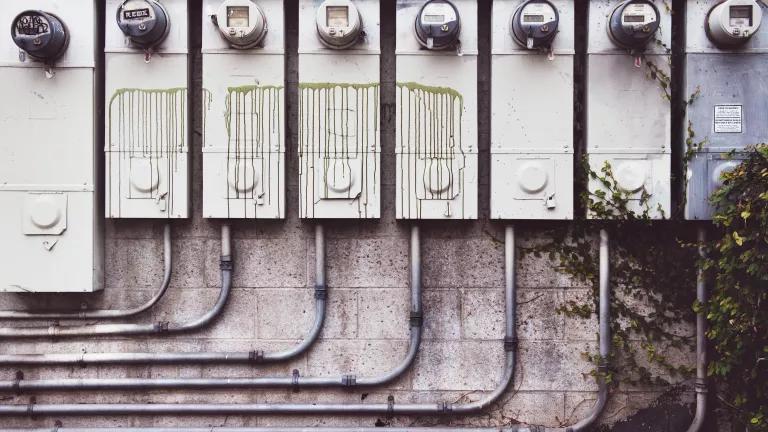The Methane Math for Gas Tankless Water Heaters

Once promoted as a more energy efficient option for providing hot water in homes and businesses than conventional tank-type water heaters, gas tankless water heaters may not be that much better for the climate when accounting for methane emissions—the primary component of gas and a climate-warming super pollutant—finds a study by Stanford researchers. These tankless water heaters emit twice as much unburnt methane because they fire up their gas burners, and release a puff of methane, every time hot water is used. This is true even when only a small amount of water is used, like for hand washing or rinsing a cup.
In fact, unburnt methane from gas tankless water heaters has a much higher global warming potential (GWP) than carbon dioxide—86 times as much over a 20-year horizon. Small amounts of unburnt methane escaping to the atmosphere via the water heater flue add up quickly, offsetting much of the energy-saving benefits of tankless water heaters compared to tank-type gas heaters (also known as gas storage water heaters).
Water-heating is the largest use of gas in California homes, and second-largest in homes nationally after space heating. And the vast majority of new water heaters sold in the state today use gas. The tankless heaters save energy because they use electronic ignition instead of pilot lights, and they also don’t need to store water in a tank, where it gradually loses heat until it gets reheated. However, this conventional math only accounts for energy use, and carbon dioxide (CO2) emissions, the primary by-product of gas combustion. The Stanford study finds that gas tankless water heaters leak more than twice the amount of methane (CH4) than gas tank types do.
Unbeknownst to the user, every time a tankless water heater fires up its burners, or switches them off, it emits a puff of methane, largely due to incomplete combustion:

Tankless heaters also emit more than twice as much methane while the burners are on than tank heaters, adding up to 0.93 percent of unburnt methane in tankless vs. 0.39 percent in tank heaters.
This appears small but as noted earlier, methane is 86 times more powerful than CO2 from a heat-trapping perspective over a 20-year horizon. A small amount of leakage adds up to a large impact. In fact, while tankless water heaters are theoretically 22 percent more energy efficient than tank heaters, this advantage is in part offset by the higher methane emissions. NRDC estimates that when factoring in methane emissions rates per the study’s findings, tankless water heaters only reduce emissions by 14 percent vs. gas tank heaters, instead of the 22 percent conventional estimate.
This slight climate advantage of gas tankless over tank heaters is dwarfed by the 50- to 70-percent emissions reduction provided by electric heat pump water heaters, and by the ultimate drop to zero emission as the electric grid becomes 100-percent clean, such as in the 13 states with 100 percent clean electricity goals. Heat pump models have another key benefit: they help clean up the air, eliminating air pollution from gas combustion that hurts public health.
What this means for our climate and clean air goals
Gas tankless water heaters currently have a small market share, just around 2 percent of gas water heater sales in the United States. While the Stanford study has a relatively modest sample size, 35 water heaters, and the emissions numbers will be refined by larger studies, the direction is clear: methane emissions are a key piece of the climate equation.
Accounting for methane reinforces what other studies have already found: we cannot get anywhere close to our clean energy goals in buildings through energy efficiency alone, such as by moving from gas tank to tankless water heaters. Instead we must transition our homes and buildings off fossil fuels to clean and efficient electric space and water heating technology in the form of heat pumps, which are 3 to 5 times more efficient than the most efficient gas technology and can also help move to a 100-percent clean energy grid.
Starting with new construction
The first place to start is in new construction: we need to build homes right from the start to save future homeowners the much higher expense of upgrading later. This must include using clean and highly efficient heat pumps for space and water heating instead of fossil-fueled furnaces and water heaters.
California has a unique opportunity to lead in this area, building off the 34 cities and counties that have already adopted local building codes that require or strongly encourage electric construction, by shifting new construction from gas tankless to heat pump water heaters.
It is time to stop building new homes with the gas tankless water heaters currently favored by the California energy code: they are only marginally more efficient than gas tank water heaters, and they lock in homeowners into higher emissions, pollution, and utility costs.
Less than 1 percent of all homes get built every year, but new construction has an outsize influence on the market (every new home needs new equipment, whereas water heaters only get replaced every 10 to 15 years in existing buildings). New construction is also the most cost-effective time to go electric.
What to do until you can upgrade to a clean energy water heater?
Water heaters last for 10 to 15 years and can be expensive to replace. When your water heater gets close to its end-of-life, consider upgrading to an electric heat pump water heater. Even if you currently use gas for water heating, an electric heat pump water heater is so much more efficient than even the best gas models, it will save energy and money over its life. Make sure to research available options and when possible, go ahead with the replacement before your water heater fails, as it is easier to upgrade when you can plan for it than in an emergency situation.
If you’re thinking of going for an electric tankless model, consider this: while they don’t have the methane problem, they use three times as much energy as heat pump water heaters, costing you dearly, and they are arguably no better for the climate than gas water heaters. This is because they draw electricity, a lot of it, exactly when users need hot water, which tends to coincide with times of higher power demand on the grid and emissions from power plants. This makes it more difficult to transition the grid to 100 percent clean energy to clean our air and stave off the worst of the climate crisis. We need efficient and flexible heat pump water heaters, not inefficient and inflexible electric tankless models.
If you’re staying with your gas tankless water heater for now
If your water heater still has significant life in it, the Stanford study has an interesting tip on how to minimize those methane puffs every time your tankless water heater turns on and off.
You may be inadvertently causing the water heater to fire up and emit these methane puffs if you lift your sink’s or bathroom’s single faucet handle straight up, even when you don’t need hot water or don’t even wait for it. The researchers measured the angle required to trigger the water heater on six single-handle kitchen faucets, and found that all six triggered the tankless water heater (TWH) when the handle was right in the middle:

If you don’t need hot water, make sure to move your sink handle fully to the right so that it doesn’t inadvertently call for hot water.
This problem exists for all water heater types and eventually needs to be fixed by energy efficiency standards for faucets. In the meantime, you can greatly reduce these impacts by moving the handle to the right, and when the time comes, by upgrading to a clean energy and super-efficient water heater.
Methodological notes
Comparing minimum efficiency devices with 0.81 and 0.63 uniform energy factor respectively, which are the most-commonly sold models.
The net greenhouse gas impact of 14% differs from the study’s 18% because NRDC uses the more common minimum efficiency models instead of the average efficiency of the sample in the Stanford study.


